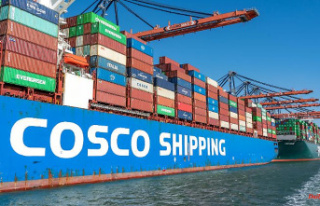The first hydrogen delivery from the United Arab Emirates arrives in the port of Hamburg - by transport as ammonia. It is part of a deal signed by Economics Minister Habeck. He also turns on the gas valve. However, he cannot turn criticism of the delivery away.
With the symbolic opening of a gas tap, Federal Economics Minister Robert Habeck received the first hydrogen test delivery from the United Arab Emirates on the premises of the Hamburg copper manufacturer Aurubis. It is the prelude to further deliveries that the Greens politician had agreed to during a trip to the Gulf States in spring and which is considered a test run for setting up a hydrogen value chain between Germany and the UAE.
"Now more than ever we have to push ahead with the ramp-up of hydrogen," said the Green politician, who came to Aurubis together with the Minister of Industry of the Emirates, Sultan Al Jaber, and Hamburg's Mayor Peter Tschentscher. In Germany, its own production of "green" hydrogen is being set up. "But of course we also need hydrogen from imports." "Green" hydrogen produced with green electricity should help in the future to do without fossil fuels in industrial production.
Sultan Al Jaber emphasized that his country has invested heavily in the development of hydrogen technology and that he intends to continue driving this together with the German partners in the future. Habeck signed several partnerships in Abu Dhabi in mid-March to set up a hydrogen value chain between Germany and the United Arab Emirates.
The first test delivery from the UAE is still so-called blue hydrogen, which is not produced using renewable energy like the "green" one, but with natural gas. The hydrogen supplied by the Abu Dhabi National Oil Company was shipped in the form of the hydrogen derivative ammonia and was handled by Hamburg port logistics HHLA in September. Compared to hydrogen, ammonia is easier, more efficient and cheaper to store and transport.
Aurubis will use the hydrogen for an initial eight-week test run for the climate-neutral conversion of copper wire production. "We want to produce in a climate-neutral manner - well before 2050," said Aurubis CEO Roland Harings. The aim of the pilot project is to show: "The development of a 'blue' and in the future 'green' ammonia value chain between Germany and the United Arab Emirates is not only theoretically possible, but also works in practice."
The Hamburg Senate wants to turn the Hanseatic city into a hydrogen hub and is planning to set up its own production facility with a so-called electrolyser in the port. "Hamburg aims to become a leading hydrogen location in Europe," said Mayor Tschentscher. According to the SPD politician, the port offers the best conditions for the import and sale of regenerative energy sources. "As a globally networked trading and logistics metropolis, Hamburg can contribute its expertise to the energy partnership between Germany and the United Arab Emirates."
The German Federation for the Environment and Nature Conservation (BUND) criticized the first ammonia test delivery. "The production of hydrogen from natural gas consumes enormous amounts of natural gas not only for the end product, the hydrogen, but also for the production process under high pressure and high heat," said BUND country manager Lucas Schäfer.
In addition, there is the energy loss for the conversion of hydrogen into ammonia for transport as well as for the CO2 capture and the underground storage of the greenhouse gas. Overall, "blue hydrogen" is more than 20 percent more harmful to the climate than the direct combustion of coal or natural gas.












